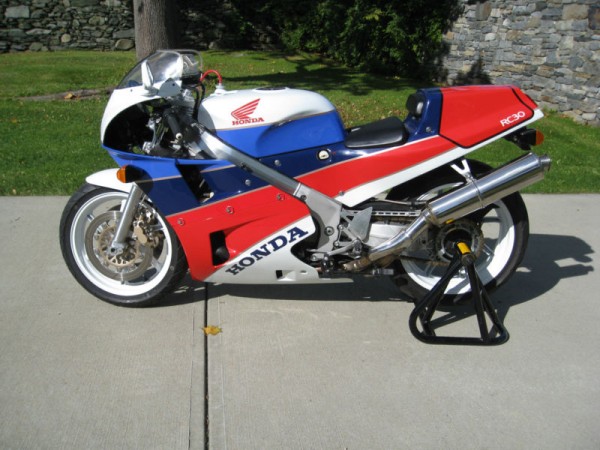

The model wouldn’t be offered in America until 1990 - the only year it was officially sold on US shores - despite it being released to Europe and most of the other global markets in ’88. The VFR750R (the name given to this bike in other markets) was first released in 1987, though only in Honda’s native Japanese market. In total, only 316 RC30s were sold in the US. The bike’s fork sliders also allowed the front calipers to remain in place during wheel changes, a feature that, like the ELF-designed single-sided swing-arm, was born out of competition for ultra-quick pit stops. The RC30 got fully-adjustable Showa suspension fore and aft - 43mm telescopic forks up front and a mono-shock out back.īraking duties went to a pair of fully floating 310mm discs bit by four-piston Nissin calipers in the front and a single 220m unit pinched by a dual-pot caliper in the rear. The VFR had a top speed of over 150mph, and thanks to an incredibly high gear ratio, could break 80 mph in first gear.

The VFR750R had a best-in-class dry weight of 396 lbs and a wet weight of 488 lbs, which was almost 10 lbs less than the game-changing Suzuki GSX-R750. Paired with a six-speed transmission with a trick slipper clutch, the sophisticated V4 made 118 hp at 11,000 rpm and 55 ft-lbs of torque at 9,800rpm (unrestricted). Japan called it the VFR750R, but the bike we fell in love with in America was named the RC30.Īt the heart of the RC30 was a liquid-cooled, 748cc, 90-degree V4 engine with four valves per cylinder, gear-driven double-overhead cams, titanium connecting rods, forged two-ring pistons, an 11.0:1 compression ratio, and a “big bang” firing order. The result was a no-expense-spared race-grade legend brimming with features previously reserved for track-only machinery. Knowing it would only have to turn out a relatively small batch of machines, Soichiro Honda wanted to use the new model to demonstrate what its factory race department was capable of. So they set out to create a new top-shelf, street-legal, limited edition race bike, producing the minimum number of units required to satisfy homologation rules. When the new World Superbike Championship was introduced in 1988, Honda had an issue as its highly successful custom-built RVF750 factory endurance racer (not the RC45) wouldn’t be eligible to compete. Additional photos are available here for your perusal. They should make them like that now.Click here for an CycleVIN Motorcycle History Report on this 1990 Honda RC30. I remember describing the feeling of riding one as like reaching forward and gripping the front wheel axle in your hands, your arms acting as the forks. The L model ZXRs junked the hoover tubes in favour of a proper ram-air duct, but were still pretty tough-looking bikes. The late, great technical bike journalist John Robinson had a TTS-tuned 805cc big-bore ZXR750 J1, and it remains one of the raunchiest, noisiest, scariest, most fun bikes I’ve ever ridden. The J model still had the H’s hoover ducts but smoother, racier styling. Especially the J models – originally came in plain blue and burgundy red, which were damn cool and better than they sound. They were exotica for the masses, and the masses were duly grateful.Ĩ) Kawasaki ZXR750 J1 and 2, and L1, 2 and 3īookended by the H model ZXRs (from the late 80s and not all that, truth be told – too stiff, bit boxy to look at, basically a GPX750 with a bra and knickers on) and the later ZX-7R (fugly, lardy etc), the best ZXRs are the ones in the middle. Never mind that a few were painted lovelies, shipped via Thailand for a dubious repaint. They share the same sliver of Soichiro Honda’s soul, as well as the same gear-driven cams, same intestinal gurgle at low revs, same gnawing wail at high revs, and the same utterly enthralling attention to detail and build quality. The older, softer VFR400R NC30 and later, sharper RVF400R are built from the same DNA as the RC30 and RC45. Who could resist the charms of the little blighters? All were gorgeous, but the Honda V4s were the ones to have. This was the dilemma facing riders in the mid-'90s.

The biggest problem would be deciding which to buy. Especially if they cost around £3000 tops, used. Now that’s a bunch of sportsbikes I’d be interested in. Remember the 1990’s invasion of cheap, refurbished, discarded baby sportsbikes from Japan, otherwise known as Grey Imports? Imagine how unbearably cute a modern GSX-R400 would be, or a ZX-4R, a crossplane R4, a baby Blade.


 0 kommentar(er)
0 kommentar(er)
